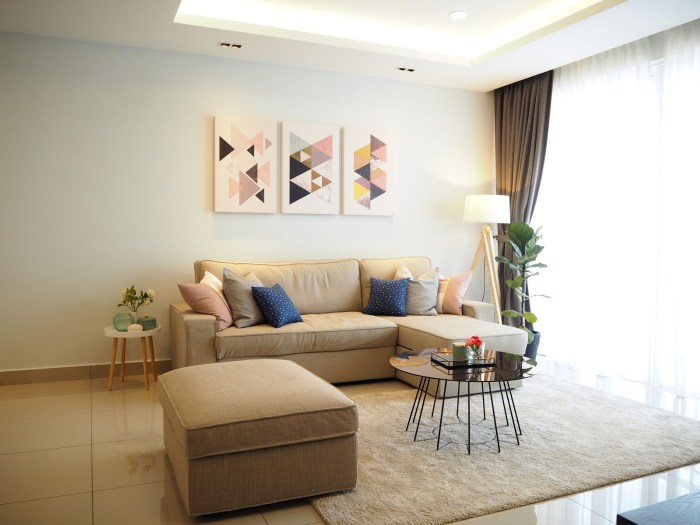Interior Design on a Budget: Transforming Spaces Without Breaking the Bank

Embark on a journey through the realm of interior design on a budget, where creativity meets financial constraints to create stunning living spaces. From innovative solutions to stylish transformations, explore the art of designing on a dime.
Delve into the nuances of setting a budget, navigating DIY projects versus professional assistance, and discovering budget-friendly furniture and decor options. Let's unlock the secrets to maximizing space, choosing colors, and patterns that breathe life into your home without draining your wallet.
Introduction to Interior Design on a Budget
Interior design on a budget refers to the practice of creating stylish and functional living spaces while being mindful of cost constraints. It involves finding creative and affordable solutions to transform a space without breaking the bank.
Implementing budget-friendly design solutions is essential for individuals or families who want to enhance their living environment without overspending. It allows people to achieve their desired aesthetic and functionality without compromising on quality.
Examples of Successful Interior Design Projects Done on a Budget
- Repurposing Furniture: Upcycling old furniture pieces or purchasing second-hand items can significantly reduce costs while adding character to a space.
- DIY Projects: Engaging in do-it-yourself projects such as painting walls, creating artwork, or sewing curtains can personalize a space and save money on labor costs.
- Strategic Shopping: Hunting for discounts, sales, and clearance items can help individuals acquire high-quality decor and furnishings at a fraction of the original price.
- Minimalism: Embracing a minimalist design approach can reduce the need for excessive furniture and decor, resulting in a sleek and cost-effective interior.
Setting a Budget for Interior Design

Determining a budget for an interior design project is crucial to ensure that you stay within your financial means while still achieving the desired outcome. Here are some tips on how to set a budget and allocate it effectively:
Allocate Budget to Different Aspects of Design
When setting a budget for interior design, it's important to allocate funds to different aspects of the project to ensure a balanced and cohesive look. Here are some tips on how to distribute your budget effectively:
- Start by prioritizing key elements such as furniture, decor, lighting, and paint.
- Consider investing more in items that have a significant impact on the overall look and feel of the space, such as a statement piece of furniture or a unique lighting fixture.
- Look for cost-effective options for items that are easily replaceable or updated, such as throw pillows, rugs, or wall art.
- Don't forget to budget for any necessary renovations or repairs that may be required before beginning the design process.
Benefits of Setting a Clear Budget
Setting a clear budget from the beginning of an interior design project offers numerous benefits, such as:
- Helps you prioritize spending and avoid overspending on unnecessary items.
- Allows you to make informed decisions about where to allocate your funds for maximum impact.
- Prevents financial stress and ensures that you can enjoy the design process without worrying about going over budget.
- Gives you a clear roadmap to follow throughout the project, making it easier to stay on track and achieve your design goals within your financial constraints.
DIY vs. Hiring Professionals
When it comes to interior design on a budget, the decision between tackling projects yourself or hiring professionals can greatly impact both the outcome and the cost. Let's compare the pros and cons of each approach to help you make informed decisions.
DIY Projects
DIY projects can be a great way to save money on interior design. Here are some tips to make the most of your DIY endeavors:
- Start with small projects like painting walls or upcycling furniture before attempting larger renovations.
- Research tutorials and guides online to learn new techniques and gain inspiration.
- Shop smart by looking for budget-friendly materials and supplies at thrift stores, discount shops, or online marketplaces.
- Don't be afraid to get creative and think outside the box to achieve a customized look without breaking the bank.
Hiring Professionals
While DIY projects can be cost-effective, there are times when investing in professional help is worth it:
- Complex projects like electrical work, plumbing, or structural changes are best left to professionals to ensure safety and compliance with building codes.
- Professional designers can provide expert advice, innovative ideas, and access to exclusive resources that may not be available to the average homeowner.
- If you lack the time, skills, or motivation to complete a project on your own, hiring professionals can save you stress and ensure a high-quality result.
- Consider the long-term value of professional design services, as they can enhance the functionality, aesthetics, and resale value of your home.
Furniture and Decor Shopping on a Budget
When it comes to interior design on a budget, finding affordable furniture and decor is key. Here are some tips to help you achieve a stylish look without breaking the bank.
Budget-Friendly Stores
- IKEA: Known for its affordable and modern furniture pieces.
- Target: Offers a wide range of stylish decor items at budget-friendly prices.
- Wayfair: Provides a variety of options for every budget, from furniture to home accessories.
- HomeGoods: Great for finding unique decor pieces at discounted prices.
Finding Affordable Pieces
One way to find affordable yet stylish furniture and decor is to shop sales, clearance sections, and thrift stores. You can also look for online marketplaces where you can buy second-hand items at a fraction of the cost.
Repurposing and Upcycling
If you already have furniture pieces that don't quite fit your design theme, consider repurposing or upcycling them. For example, you can paint old furniture to give it a fresh look, or repurpose items for a new function in your space.
Maximizing Space and Functionality
When working with small rooms or apartments, maximizing space and functionality is key to creating a comfortable living environment. By utilizing smart design techniques and choosing the right furniture, you can make the most out of limited space without compromising on style.
Ideas for Maximizing Space
Maximizing space in small rooms can be achieved through various strategies, such as:
- Utilizing vertical space with tall shelving units or wall-mounted storage.
- Opting for furniture with hidden storage compartments, such as ottomans or beds with built-in drawers.
- Using mirrors to create the illusion of a larger space and reflect light throughout the room.
The Importance of Multifunctional Furniture
Multifunctional furniture plays a crucial role in budget-friendly design by serving multiple purposes within a limited space. Pieces like sofa beds, extendable dining tables, and nesting tables can help you save space and money while maintaining functionality.
Tips for Organizing and Decluttering
Organizing and decluttering are essential steps in improving functionality within a space. Consider the following tips:
- Regularly evaluate your belongings and get rid of items you no longer need or use.
- Invest in storage solutions like baskets, bins, and drawer organizers to keep things tidy.
- Utilize vertical organizers, such as hooks or pegboards, to maximize wall space for storage.
Choosing Colors and Patterns
When it comes to interior design on a budget, choosing the right colors and patterns can make a significant impact on the overall look and feel of a space. By carefully selecting colors and incorporating patterns strategically, you can achieve a stylish and cohesive design without breaking the bank.
Impact of Color Choices
Color choices play a crucial role in setting the tone for a room. Opting for neutral colors like whites, grays, and beiges can create a timeless and versatile look that allows you to easily switch up accent pieces without major renovations.
Bold colors can add personality and depth to a space, but be mindful of using them in moderation to avoid overwhelming the room.
Tips for Incorporating Patterns
- Start small with accessories: Introducing patterns through throw pillows, rugs, or curtains is a budget-friendly way to experiment with different designs without committing to a large-scale change.
- Mix and match wisely: Combining patterns of varying scales and styles can add visual interest to a room. Just make sure to choose patterns that complement each other rather than clash.
- Focus on one statement piece: Instead of covering every surface with patterns, select one standout piece like a bold accent wall or a vibrant piece of furniture to serve as the focal point.
Examples of Budget-Friendly Color Schemes
| Color Scheme | Description |
|---|---|
| Monochromatic | Using varying shades of a single color can create a sophisticated and cohesive look. |
| Complementary | Pairing colors that are opposite each other on the color wheel can create a vibrant and dynamic space. |
| Analogous | Choosing colors that are next to each other on the color wheel can result in a harmonious and comforting atmosphere. |
Wrap-Up

As we conclude our exploration of interior design on a budget, remember that creating a beautiful living space doesn't have to come with a hefty price tag. By blending creativity with practicality, you can achieve a home that reflects your style and personality while staying within your financial means.
Dive into the world of budget-friendly design and watch your space transform before your eyes.
FAQ Compilation
How can I determine an appropriate budget for my interior design project?
To set a budget, consider factors like room size, desired style, quality of materials, and whether you'll be DIY-ing or hiring professionals. Research costs of furniture, decor, and labor to arrive at a realistic budget.
What are some budget-friendly furniture and decor stores to explore?
Shops like IKEA, Target, Wayfair, and thrift stores offer affordable yet stylish options. Online marketplaces like Etsy and Facebook Marketplace can also be great for unique finds at budget-friendly prices.
How can I make the most of a small space on a budget?
Opt for multifunctional furniture like storage ottomans or wall-mounted shelves. Use light colors to create an illusion of space and mirrors to reflect light. Declutter regularly to maintain a sense of openness.

